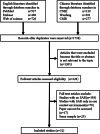A network meta-analysis of secondary attack rates of COVID-19 in different contact environments
- PMID: 35686655
- PMCID: PMC8523971
- DOI: 10.1017/S0950268821002223
A network meta-analysis of secondary attack rates of COVID-19 in different contact environments
Abstract
As the corona virus disease 2019 (COVID-19) pandemic continues around the world, understanding the transmission characteristics of COVID-19 is vital for prevention and control. We conducted the first study aiming to estimate and compare the relative risk of secondary attack rates (SARs) of COVID-19 in different contact environments. Until 26 July 2021, epidemiological studies and cluster epidemic reports of COVID-19 were retrieved from SCI, Embase, PubMed, CNKI, Wanfang and CBM in English and Chinese, respectively. Relative risks (RRs) were estimated in pairwise comparisons of SARs between different contact environments using the frequentist NMA framework, and the ranking of risks in these environments was calculated using the surface under the cumulative ranking curve (SUCRA). Subgroup analysis was performed by regions. Thirty-two studies with 68 260 participants were identified. Compared with meal or gathering, transportation (RR 10.55, 95% confidence interval (CI) 1.43-77.85), medical care (RR 11.68, 95% CI 1.58-86.61) and work or study places (RR 10.15, 95% CI 1.40-73.38) had lower risk ratios for SARs. Overall, the SUCRA rankings from the highest to the lowest were household (95.3%), meal or gathering (81.4%), public places (58.9%), daily conversation (50.1%), transportation (30.8%), medical care (18.2%) and work or study places (15.3%). Household SARs were significantly higher than other environments in the subgroup of mainland China and sensitive analysis without small sample studies (<100). In light of the risks, stratified personal protection and public health measures need to be in place accordingly, so as close contacts categorising and management.
Keywords: COVID-19; Contact environment; network meta-analysis; secondary attack rate.
Conflict of interest statement
No conflict of interest exists in the submission of this manuscript.
Figures


Similar articles
-
Household Transmission of SARS-CoV-2: A Systematic Review and Meta-analysis.JAMA Netw Open. 2020 Dec 1;3(12):e2031756. doi: 10.1001/jamanetworkopen.2020.31756. JAMA Netw Open. 2020. PMID: 33315116 Free PMC article.
-
A network meta-analysis of risk factors of infection among close contacts of COVID-19.Heliyon. 2023 Oct 10;9(10):e20861. doi: 10.1016/j.heliyon.2023.e20861. eCollection 2023 Oct. Heliyon. 2023. PMID: 37860512 Free PMC article.
-
Factors Associated With Household Transmission of SARS-CoV-2: An Updated Systematic Review and Meta-analysis.JAMA Netw Open. 2021 Aug 2;4(8):e2122240. doi: 10.1001/jamanetworkopen.2021.22240. JAMA Netw Open. 2021. PMID: 34448865 Free PMC article.
-
SARS-CoV-2 seroprevalence and transmission risk factors among high-risk close contacts: a retrospective cohort study.Lancet Infect Dis. 2021 Mar;21(3):333-343. doi: 10.1016/S1473-3099(20)30833-1. Epub 2020 Nov 2. Lancet Infect Dis. 2021. PMID: 33152271 Free PMC article.
-
Household secondary attack rate of COVID-19 and associated determinants in Guangzhou, China: a retrospective cohort study.Lancet Infect Dis. 2020 Oct;20(10):1141-1150. doi: 10.1016/S1473-3099(20)30471-0. Epub 2020 Jun 17. Lancet Infect Dis. 2020. PMID: 32562601 Free PMC article.
Cited by
-
Association of healthcare worker behaviors with coronavirus disease 2019 (COVID-19) risk during four pandemic periods and characteristics associated with high-risk behaviors.Antimicrob Steward Healthc Epidemiol. 2023 Jan 17;3(1):e16. doi: 10.1017/ash.2022.371. eCollection 2023. Antimicrob Steward Healthc Epidemiol. 2023. PMID: 36714294 Free PMC article.
-
Oro-faecal transmission of SARS-CoV-2: A systematic review of studies employing viral culture from gastrointestinal and other potential oro-faecal sources and evidence for transmission to humans.Epidemiol Infect. 2024 Nov 12;152:e138. doi: 10.1017/S0950268824001481. Epidemiol Infect. 2024. PMID: 39529596 Free PMC article.
-
Associated factors in SARS-CoV-2 infection among close contacts during the zero-COVID policy from 2020 to 2022 in the northeast of Shenzhen, China: a retrospective cohort study.Front Public Health. 2025 Jun 11;13:1589683. doi: 10.3389/fpubh.2025.1589683. eCollection 2025. Front Public Health. 2025. PMID: 40567988 Free PMC article.
-
SARS-CoV-2 transmission modes: Why and how contamination occurs around shared meals and drinks?Food Microbiol. 2023 Sep;114:104297. doi: 10.1016/j.fm.2023.104297. Epub 2023 May 12. Food Microbiol. 2023. PMID: 37290873 Free PMC article. Review.
-
Estimating the household secondary attack rate and serial interval of COVID-19 using social media.NPJ Digit Med. 2024 Jul 20;7(1):194. doi: 10.1038/s41746-024-01160-2. NPJ Digit Med. 2024. PMID: 39033238 Free PMC article.
References
-
- Listings of WHO's response to COVID-19. Available at https://www.who.int/news/item/29-06-2020-covidtimeline (Accessed 29 June 2020).
-
- Wiersinga WJ et al. (2020) Pathophysiology, transmission, diagnosis, and treatment of coronavirus disease 2019 (COVID-19): a review. JAMA 324, 782–793. Published online: 11 July 2020. - PubMed
-
- Hui-hui Z et al. (2020) Epidemic characteristics of close contacts of coronavirus disease 2019 in Xi'an. Journal of Xi'an Jiaotong University (Medical Sciences) 41, 502–505.
-
- Hui-Jun L et al. (2020) Treatment and analysis of a clustering pneumonia caused by 2019-nCoV in Wuzhi county. Henan Journal of Preventive Medicine 31, 573–576.
Publication types
MeSH terms
LinkOut - more resources
Full Text Sources
Medical
Research Materials
Miscellaneous

